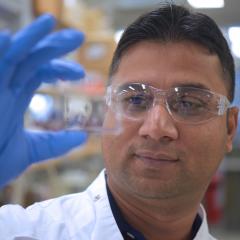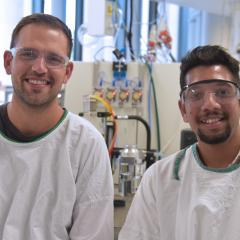The grand opening of The Australian Research Council (ARC) hub for Advanced Manufacture of Targeted Radiopharmaceuticals (AMTAR) marks a new era for local biomanufacturing and radiopharmaceutical production.
AIBN researchers Dr James Wood and Dr Saikat Ghosh were among the first cohort of postdocs to enter the AMTAR ecosystem and, since January, have been working with industry partner Telix Pharmaceuticals to find novel targets for radiopharmaceuticals.

The pair have already made significant progress in their partnership with Telix and, as we prepare to cut the AMTAR ribbon, are proof that the hub provides the ideal environment for academia and industry to make translatable discoveries.
We sat down with James and Saikat to talk about what they’ve been up to so far with AMTAR, and how the hub will change lives.
-
James and Saikat, thanks for chatting AMTAR. It’s been a while since we first heard about the hub. How does it feel to have things up and running?
James: It’s great - we've been working on stuff since January. We already have a number of projects on the go.
Saikat and I are specifically linked with Telix Pharmaceuticals. There are a few other researchers at AMTAR who have been paired up with other companies too. Stay on top of our industry news and developments, events and opportunities, by joining The NetworkJoin The Network
Saikat: I would say the work we’re doing with Telix is actually not too dissimilar to what we would usually be doing, this is just more of an industry focus. Our industry partner has certain ideas they want us to pursue with the unique capability and infrastructure that AMTAR possesses. So, it's a mutual relationship. The research hub provides the equipment and expertise, they are coming to the table with resources and a mutual vision that builds capacity in the field.
J: Yeah a lot of these companies have fantastic ideas but might not have actual lab space or other capabilities necessary to do their research. With the AMTAR hub, it brings it all into the one place.
When you say you’re ‘working with Telix’, what does that mean exactly?
J: So the AMTAR hub will have a number of postdoctoral researchers that form collaborations with industry partners who come on board. Specifically for their work, Telix required someone who is chemistry focused and someone who biology focused. I’ve taken up the radiochemistry work, and Saikat the radiobiology work.

But we're sort of taking more of a mixed approach, I guess. Because we both have overlapping skills. We can then step in for one another if needed and provide a truly interdisciplinary approach to help solve problems for Telix.
You probably can’t speak specifcs about the projects, but it sounds like a fairly collaborative arrangement with Telix?
S: Yes, they've given us a number of fairly complex questions and problems that they want us to focus on to start with. But Telix has also been quite relaxed with how much freedom they give us. They really want our input as well, and so it is a truly collaborative relationship.
They're kind of like: ‘here's the problem we're trying to tackle, do you guys have any specific ideas?’ So we are able to go away and do a bit of our own research and come up with some suggestions for things they might not have considered. So that's cool.
J: Yes our partnership… it’s not completely structured and strict. You get a little bit of leeway to innovate. We get to work on predescribed projects, as well as bring our own ideas into those projects. So it's a good balance.
Why should biotech companies look to AMTAR to develop their products? Does it help that the postdocs there know the industry?
J: Yeah, I think businesses don't just want to work with people who’ve only got lab experience, right? They want researchers who know how business works. Sometimes there is hesitance for industry to link up with academia. I sense that for a lot of businesses, working with academia is hard to imagine because the perception is that everyone is working to different timelines with different goals.

Speaking for myself, I had the benefit of working with Telix throughout my PhD. So I already sort of know how to tackle talking about projects, what is acceptable to disclose and things like that. So I think that kind of makes it easier to work with them.
That PhD work was similar to what we're doing here at AMTAR now. Ligand design for targeted radiotherapy. It boils down to organic chemistry. Designing from the ground up, the cage that holds on to those radiometals.
Saikat for those who weren’t in the room earlier… what is a radiopharmaceutical?
S: In relevance to cancer, a targeted radiopharmaceutical is a new type of drug that is extremely specific to that cancer, meaning, it spares healthy parts of the body from harsh side-effects of radiation. Basically, we’re attaching a powerful radioisotope to a cancer targeting agent , which can be administered into a patient and will go exactly where it's supposed to go. It will find its way to the cancer and eventually eliminate it.

AMTAR is unique in that, throughout the world, there are not many who deal with what we call Alpha therapies. It’s widely considered the most potent radiation, and you can find it as a key research strategy to support partners in AMTAR’s vision.
While there are a lot of places that work with radiation, this hub is unique in that we focus on those Alpha targeted therapies; these very potent treatments are needed in much lesser doses than other radiations. AMTAR also provides a translational pathway that builds on expertise from both the academic and industry partner.
James how excited should we be about radiopharmaceuticals? Are they really a promising option for cancer patients?
J: Oh absolutely. I guess for me, the main benefit is that radiopharmaceuticals are making cancer treatments more personalised. It means we can start screening people for certain biomarkers and then develop a radiopharmaceutical regime that you know is going to work. I think a lot of time now with chemotherapy, It's just kind of a very ‘bust the door down’ approach to eliminating tumours.
S: Even untargeted radiotherapy is like carpet bombing. It tries to kill all cells, cancerous or otherwise, in its path.
J: Yes. You see the patient feeling really, really ill throughout it, for obvious reasons. Whereas with radiopharmaceuticals, with the consent of a patient, you can screen for all these biomarkers, and you can say which drug is going to have a high chance of working. And the people it works for will hopefully have a greatly improved quality of life.
S: I think is the novelty with radiopharmaceuticals is that there are many cancers which are resistant to chemotherapy, and there are cancers which cannot be reached, like with brain cancer for example. Radiopharmaceuticals allow us to get into places you usually couldn’t.
It’s also a something you can combine with other therapies as well. You can combine it with surgery, combining it with other treatment options. So in that way it's a very promising field right now.
Do you think we’re shifting towards a more personalised model of healthcare in general?
S: I think healthcare is definitely heading that way, and that is a good thing because every cancer is different. Every patient is different. They will not have the same expression of those cancer targets. And once we understand what those targets are, we can use data science and informatics tools and then develop a more precise therapy regimen.
J: It feels like the infrastructure is also progressing at the same rate that the science is. I think a lot of hospitals already have the existing facilities to handle all of these new bits and pieces. And I guess most of our research is done with that in mind as well.




